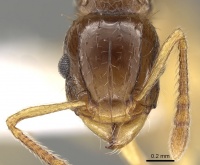Tetramorium tenuicrine
| Tetramorium tenuicrine | |
|---|---|

| |
| Scientific classification | |
| Kingdom: | Animalia |
| Phylum: | Arthropoda |
| Class: | Insecta |
| Order: | Hymenoptera |
| Family: | Formicidae |
| Subfamily: | Myrmicinae |
| Tribe: | Crematogastrini |
| Genus: | Tetramorium |
| Species: | T. tenuicrine |
| Binomial name | |
| Tetramorium tenuicrine (Emery, 1914) | |
Reported from rainforest habitat.
Identification
Bolton (1977) - This species, known only from New Caledonia and the Fiji Islands, represents the furthest easterly penetration of Tetramorium species with 11 antennal segments. It is not easy to relate this form to any other II-segmented species but its lack of propodeal armament and very reduced sculpture make it easily identifiable.
Distribution
Latitudinal Distribution Pattern
Latitudinal Range: 16.766667° to -20.992°.
| North Temperate |
North Subtropical |
Tropical | South Subtropical |
South Temperate |
- Source: AntMaps
Distribution based on Regional Taxon Lists
Australasian Region: New Caledonia (type locality).
Indo-Australian Region: Fiji.
Distribution based on AntMaps
Distribution based on AntWeb specimens
Check data from AntWeb
Countries Occupied
| Number of countries occupied by this species based on AntWiki Regional Taxon Lists. In general, fewer countries occupied indicates a narrower range, while more countries indicates a more widespread species. |

|
Estimated Abundance
| Relative abundance based on number of AntMaps records per species (this species within the purple bar). Fewer records (to the left) indicates a less abundant/encountered species while more records (to the right) indicates more abundant/encountered species. |

|
Biology
Castes
Nomenclature
The following information is derived from Barry Bolton's Online Catalogue of the Ants of the World.
- tenuicrine. Xiphomyrmex tenuicrinis Emery, 1914f: 416 (w.) NEW CALEDONIA. Combination in Tetramorium: Bolton, 1977: 88.
Unless otherwise noted the text for the remainder of this section is reported from the publication that includes the original description.
Description
Worker
Bolton (1977) - TL 3.40-3.80, HL 0.74-0.80, HW 0.64-0.74, CI 83-90, SL 0.58-0.68, SI 85-92, PW 0.52-0.58, AL 0.88-1.02 (20 measured).
Mandibles feebly striate to virtually smooth. Frontal carinae extending well beyond the level of the posterior margins of the eyes, forming the upper boundary of the feebly developed scrobe which is scarcely more than a shallow groove, not capable of containing the entire scape. Propodeum rounded to bluntly angulate but without spines or teeth, the metapleural lobes triangular and well developed. Node of petiole in profile longer than high, the anterior and dorsal surfaces confluent through a gentle curve (Fig. 13). In dorsal view both pedicel segments subglobular. Dorsum of head with median longitudinal carina present and with one or two short rugulae on each side of it, otherwise unsculptured. Promesonotal dorsum unsculptured or with a few very faint longitudinal rugulae separated by wide shining areas; propodeal dorsum usually with a few very fine rugulae. Pedicel segments and gaster smooth and shining, unsculptured. All dorsal surfaces of head and body with numerous long, fine hairs. Colour very variable. In series examined the colour has varied from entirely clear pale yellow to entirely blackish brown, the most common intermediate pattern being head and alitrunk (and usually pedicel) blackish brown, gaster and appendages yellow. Forms also occur in which the gaster is darker in shade than the alitrunk.
Type Material
Bolton (1977) - Holotype worker, New Caledonia: Vallee de la Ngoi (Sarasin & Roux) (location of type not known).
References
- Bolton, B. 1977. The ant tribe Tetramoriini (Hymenoptera: Formicidae). The genus Tetramorium Mayr in the Oriental and Indo-Australian regions, and in Australia. Bulletin of the British Museum (Natural History). Entomology. 36:67-151. (page 88, Combination in Tetramorium)
- Emery, C. 1914f. Les fourmis de la Nouvelle-Calédonie et des îles Loyalty. Nova Caled. A Zool. 1: 393-437 (page 416, worker described)
References based on Global Ant Biodiversity Informatics
- Bolton B. 1977. The ant tribe Tetramoriini (Hymenoptera: Formicidae). The genus Tetramorium Mayr in the Oriental and Indo-Australian regions, and in Australia. Bulletin of the British Museum (Natural History). Entomology 36:67-151.
- Bolton, B. "The ant tribe Tetramoriini (Hymenoptera: Formicinae. The genus Tetramorium Mayr in the Oriental and Indo-Australian regions and in Australia." Bulletin of the British Museum (National History): Entomology series 36, no. 2 (1977): 68-151.
- Chazeau J., H. Jourdan, L. Bonnet de Larbogne, J. Konghouleux, and T. Potiaroa. 2003. Etude floristique et faunistique de la foret seche de Nekoro, 2 eme partie: evaluation de l'integrite de la faune par l'etude de la myrmecofaune. Lettre de Commande Programme Forêt Sèche /lRD N°l 54/2002/CP
- Emery, C. 1914. Les fourmis de la Nouvelle-Calédonie et des îles Loyalty. Nova Caledonia. A. Zoologie 1:393-437.
- Jennings J. T., L. Krogmann, and C. Burwell. 2013. Review of the hymenopteran fauna of New Caledonia with a checklist of species. Zootaxa 3736(1): 1-53.
- Taylor R. W. 1987. A checklist of the ants of Australia, New Caledonia and New Zealand (Hymenoptera: Formicidae). CSIRO (Commonwealth Scientific and Industrial Research Organization) Division of Entomology Report 41: 1-92.
- Ward, Darren F. and James K. Wetterer. 2006. Checklist of the Ants of Fiji. Fiji Arthropods III 85: 23-47.
- Wheeler W.M. 1935. Check list of the ants of Oceania. Occasional Papers of the Bernice Pauahi Bishop Museum 11(11):1-56.
- Wheeler, W. M. 1927. The ants of Lord Howe Island and Norfolk Island. Proc. Am. Acad. Arts Sci. 62: 121-153
- Wheeler, William Morton. 1927. The Ants of Lord Howe Island and Norfolk Island. Proceedings of the American Academy of Arts and Sciences 62(4): 121-153
- Wheeler, William Morton.1935.Checklist of the Ants of Oceania.Occasional Papers 11(11): 3-56
- Wilson E. O. 1958. Observations on the behavior of the cerapachyine ants. Insectes Sociaux 5: 129-140.


